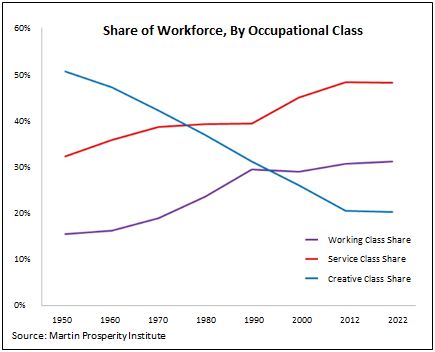Business Advisory
March 25, 2014The Business of Wine: Opus One Winery
May 1, 2014Occupational Trends
Like so many things since the Great Recession, there has been slow improvement, at times inconsistent, however the economy is generally headed in the right direction. Millennials are learning to adapt, they’re realigning their earnings expectations with the current economic environment, and are acting financially responsible regarding major purchases, including housing and other substantial financial decisions. Because of technological advancement, adjusting themselves to careers apart from the working class and into the creative class, particularly in STEM fields, is the best bet for Millennials.
 From now until the year 2022, the era of a strong working class will diminish. The working class, or those that hold jobs often related to physical labor (think: construction, factory production, transportation) and usually earn an hourly wage, is expected to become minimal. The Bureau of Labor Statistics’ (BLS) newest ten-year projection provides information on how Americans will be living and what they will be doing in the near future. Right now, the highest number of workers predicted in 2022 will belong in the service class, with jobs in retail sales or food preparation, although not the highest-paying positions. On the other hand, working class was at its highest in 1950, and will wane over time to its projected lowest in 2022.3
From now until the year 2022, the era of a strong working class will diminish. The working class, or those that hold jobs often related to physical labor (think: construction, factory production, transportation) and usually earn an hourly wage, is expected to become minimal. The Bureau of Labor Statistics’ (BLS) newest ten-year projection provides information on how Americans will be living and what they will be doing in the near future. Right now, the highest number of workers predicted in 2022 will belong in the service class, with jobs in retail sales or food preparation, although not the highest-paying positions. On the other hand, working class was at its highest in 1950, and will wane over time to its projected lowest in 2022.3
Creative class jobs will make up more than a third of jobs by the year 2020.3 These types of jobs are necessary for economic growth, and will be responsible for driving behavioral and economic patterns. Creative class encompasses careers in the science, technology, engineering and mathematics (STEM) fields, as well as business, management, professions, arts, media, and entertainment, 1 all of which allow for higher earning potential.The BLS predicts that STEM jobs will grow 55 percent faster than non-STEM jobs over the next 10 years.1
Golden Opportunity
If Millennials jump on the STEM bandwagon now, they will be able to have a positive impact on the economy in upcoming years. Becoming certified in a specific skill set, or getting a certificate or degree in STEM fields could push our economy and job growth in the right direction. After all, Millennials are predicted to makeup over 75% of the workforce by 2030.3
Once there is job certainty, apprehensions of purchasing or building new homes could subside. Then, Millennials will be self-reliant, and confident in making long-term financial commitments.
SOURCES:
- http://online.wsj.com/news/articles/SB10001424052702304732804579425120291627990
- http://online.wsj.com/news/articles/SB10001424052702304020104579429280698777544
- http://www.theatlanticcities.com/jobs-and-economy/2014/02/where-good-and-bad-jobs-will-be-10-years-now/8470/
- http://www.huffingtonpost.com/blair-christie/how-to-increase-the-stem2_b_4965591.html
- http://www.pewresearch.org/daily-number/baby-boomers-retire/
- http://www.progressivepolicy.org/2012/09/young-college-grads-real-earnings-fell-in-2011/
Contributors: Alan Arcadipane is a Business Analyst of the Business Advisory Group at Riverview Capital Advisers. Melysa Latham is a member of the Business Advisory Group at Riverview Capital Advisers.

